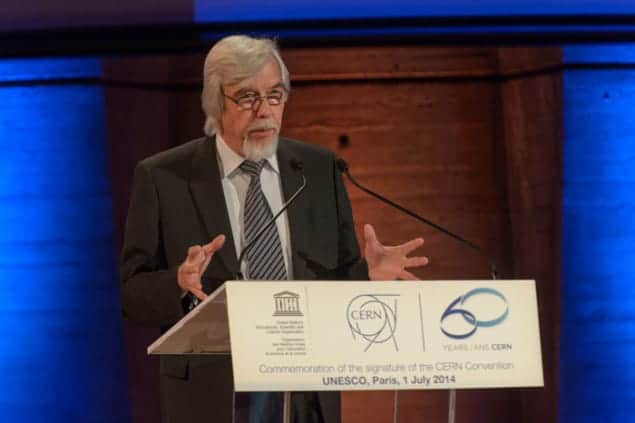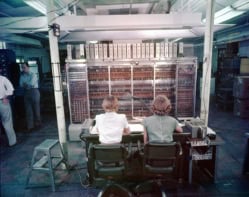
The CERN particle-physics laboratory near Geneva is celebrating its 60th anniversary this month with a host of symposia, meetings, plays, films, concerts and other events being held at the lab and at member states across Europe. CERN will mark its official birthday on Monday 29 September, which was the date when the CERN convention was ratified by its first 12 member states in 1954 and the European Organization for Nuclear Research was officially established.
Today’s event sees the laboratory celebrating the 60th anniversary of its first council session, which was actually held in Geneva on 7–8 October 1954, with a “Science and peace” symposium this afternoon, featuring talks by people involved in outreach and early-career researchers as they tell their personal stories of life at CERN. The symposium will be followed by a concert by the United Nations Orchestra at the lab’s Globe of Science and Innovation.
The special birthday symposium on 29 September, meanwhile, will include an address from CERN’s director-general Rolf-Dieter Heuer, video presentations about the history of the laboratory and the science being developed there, as well as discussions of CERN’s contributions to society at large and musical and film presentations. “With its discoveries and innovations, CERN has been bringing the world together through science for 60 years,” says Heuer. All of the events will be webcast and can be viewed the world over.
Together through science
Established in the aftermath of the Second World War by a handful of pioneering European scientists, including Nobel laureates Louis de Broglie and Niels Bohr, CERN was seen as the perfect opportunity to construct an international laboratory for fundamental research that would bring nations together through science. The 12 founding states included Belgium, Denmark, France, the Federal Republic of Germany, Greece, Italy, the Netherlands, Norway, Sweden, Switzerland, the UK and Yugoslavia. The lab now has 21 member states with many other countries from around the world – including the US, Japan and India – participating in its research programme.
The lab’s early successes included the discovery of weak neutral currents in 1973, followed by its 1983 discovery of the W and Z bosons. In early 1989, CERN scientist Tim Berners-Lee came up with his blueprint for the World Wide Web (the first servers were up and running by late 1990) and soon after, the 27 km Large Electron Positron collider (LEP) began operating. The collider, which helped to confirm the Standard Model of particle physics with extraordinary precision, was dismantled in 2000 to make way for the Large Hadron Collider (LHC).
Undoubtedly, the LHC is CERN’s most famous and successful endeavour – work began on the device in 1999, but was first switched on in September 2008, before shutting down again two days later due to failing magnets. The collider started up again in November 2009, and then swiftly hunted down the elusive and long sought-after Higgs boson by July 2012. Since then, both of the LHC’s two major detectors – ATLAS and CMS – have confirmed the findings with more data, and the discovery won François Englert and Peter Higgs the 2013 Nobel Prize for Physics for the prediction of the existence of the Higgs boson.
New frontiers
In February 2013 the LHC was turned off for a planned, major maintenance and upgrade programme following a successful three-year run operating at 7 TeV. Staff at CERN have gradually been restarting the collider since June this year and they hope that the €124m upgrade will boost the collider to the full design energy of 13 TeV.
Over the next few months, the LHC will undergo months of intensive testing to ensure that the upgrade was successful before the full physics programme can resume next year. Testing includes putting a current through each of the LHC’s eight sections and Lamont adds that all eight sections of the LHC should be cooled down by October to the operating temperature of around 2 K. By 2015 the upgraded LHC should have enhanced capabilities that will allow it to approach a new high-energy frontier.



